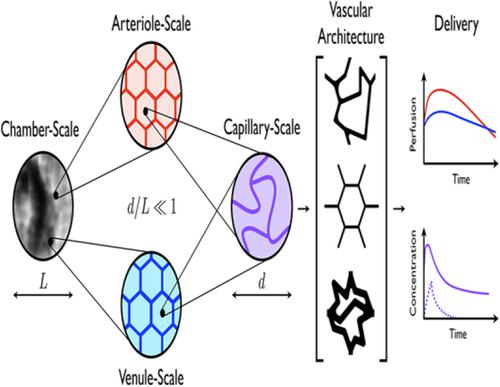当前位置:
X-MOL 学术
›
Int. J. Numer. Method. Biomed. Eng.
›
论文详情
Our official English website, www.x-mol.net, welcomes your
feedback! (Note: you will need to create a separate account there.)
A four-compartment multiscale model of fluid and drug distribution in vascular tumours.
International Journal for Numerical Methods in Biomedical Engineering ( IF 2.2 ) Pub Date : 2020-02-25 , DOI: 10.1002/cnm.3315 Rebecca J Shipley 1 , Paul W Sweeney 1 , Stephen J Chapman 2 , Tiina Roose 3
International Journal for Numerical Methods in Biomedical Engineering ( IF 2.2 ) Pub Date : 2020-02-25 , DOI: 10.1002/cnm.3315 Rebecca J Shipley 1 , Paul W Sweeney 1 , Stephen J Chapman 2 , Tiina Roose 3
Affiliation

|
The subtle relationship between vascular network structure and mass transport is vital to predict and improve the efficacy of anticancer treatments. Here, mathematical homogenisation is used to derive a new multiscale continuum model of blood and chemotherapy transport in the vasculature and interstitium of a vascular tumour. This framework enables information at a range of vascular hierarchies to be fed into an effective description on the length scale of the tumour. The model behaviour is explored through a demonstrative case study of a simplified representation of a dorsal skinfold chamber, to examine the role of vascular network architecture in influencing fluid and drug perfusion on the length scale of the chamber. A single parameter, P, is identified that relates tumour‐scale fluid perfusion to the permeability and density of the capillary bed. By fixing the topological and physiological properties of the arteriole and venule networks, an optimal value for P is identified, which maximises tumour fluid transport and is thus hypothesised to benefit chemotherapy delivery. We calculate the values for P for eight explicit network structures; in each case, vascular intervention by either decreasing the permeability or increasing the density of the capillary network would increase fluid perfusion through the cancerous tissue. Chemotherapeutic strategies are compared and indicate that single injection is consistently more successful compared with constant perfusion, and the model predicts optimal timing of a second dose. These results highlight the potential of computational modelling to elucidate the link between vascular architecture and fluid, drug distribution in tumours.
中文翻译:

血管肿瘤中液体和药物分布的四室多尺度模型。
血管网络结构和物质运输之间的微妙关系对于预测和提高抗癌治疗的疗效至关重要。在这里,数学均质化用于推导血管肿瘤的脉管系统和间质中血液和化疗药物转运的新多尺度连续模型。该框架能够将一系列血管层次的信息输入到肿瘤长度尺度的有效描述中。通过对背侧皮褶室的简化表示的示范性案例研究来探索模型行为,以检查血管网络结构在影响室长度尺度上的液体和药物灌注中的作用。确定了一个参数P ,将肿瘤范围的液体灌注与毛细血管床的渗透性和密度联系起来。通过固定小动脉和小静脉网络的拓扑和生理特性,确定了P的最佳值,该值可以最大化肿瘤液体运输,因此假设有利于化疗的输送。我们计算八个显式网络结构的P值;在每种情况下,通过降低毛细血管网络的渗透性或增加毛细血管网络的密度进行血管干预都会增加通过癌组织的液体灌注。对化疗策略进行了比较,结果表明,与持续灌注相比,单次注射始终更成功,并且该模型预测了第二次给药的最佳时机。这些结果凸显了计算模型在阐明肿瘤中血管结构与液体、药物分布之间的联系的潜力。
更新日期:2020-02-25
中文翻译:

血管肿瘤中液体和药物分布的四室多尺度模型。
血管网络结构和物质运输之间的微妙关系对于预测和提高抗癌治疗的疗效至关重要。在这里,数学均质化用于推导血管肿瘤的脉管系统和间质中血液和化疗药物转运的新多尺度连续模型。该框架能够将一系列血管层次的信息输入到肿瘤长度尺度的有效描述中。通过对背侧皮褶室的简化表示的示范性案例研究来探索模型行为,以检查血管网络结构在影响室长度尺度上的液体和药物灌注中的作用。确定了一个参数P ,将肿瘤范围的液体灌注与毛细血管床的渗透性和密度联系起来。通过固定小动脉和小静脉网络的拓扑和生理特性,确定了P的最佳值,该值可以最大化肿瘤液体运输,因此假设有利于化疗的输送。我们计算八个显式网络结构的P值;在每种情况下,通过降低毛细血管网络的渗透性或增加毛细血管网络的密度进行血管干预都会增加通过癌组织的液体灌注。对化疗策略进行了比较,结果表明,与持续灌注相比,单次注射始终更成功,并且该模型预测了第二次给药的最佳时机。这些结果凸显了计算模型在阐明肿瘤中血管结构与液体、药物分布之间的联系的潜力。











































 京公网安备 11010802027423号
京公网安备 11010802027423号